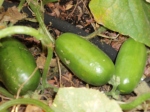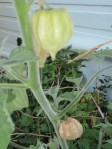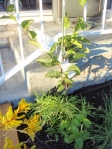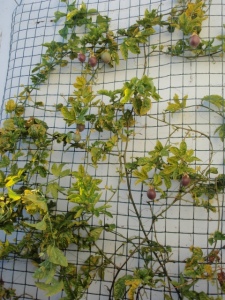This morning I went out to water and was delighted to find some cucumbers almost ready to pick.
I also took a photo of Cape Gooseberries which are a mystery to me. I have no experience of this fruit and have been trying it out at the wrong time but think that it is now about ready. Anyone who knows about this fruit I would love to hear from you. I have only one bush and don’t know if it is perennial and how big it grows or if I need several.
I bought it in a nursery because I already had two other familiar gooseberries that I remember from childhood. My late sister loved them and Mum used to make gooseberry pies. It is decades since I had gooseberry pie and I must admit it was never a favourite of mine but still I thought I might stretch to it if my bushes ever produce.
I also checked out my passionfruit vine to see if it had instantly improved since I have now fed it and watered it well. I am so disgusted by the sickly state of that vine that I have fussed over to no avail that I went out and bought another one and this time adhered to the old wives’ tale of burying a lamb’s fry under it. I did so and the new one is bursting with good health. It must be an iron feeder. I look forward to the day when this vine wraps itself around the railing and droops from the weight of passionfruit; Nellie Kelly of course. The banana passionfruit whilst much easier to grow is terribly invasive and not a patch on the black.
Nothing like a pavlova with passionfruit oozing over the cream.
Compare and contrast these two passionfruits!





Gardening not only grows food, but keeps one sane amid the craziness.
We need rain here (regional South Australia) but my tanks are still keeping the garden alive.
Right now my priority is transplanting brassicas so that we’ll have plenty to eat in June-July.
My blog started out as a garden blog, but has ventured into politics 🙂
What a lovely blog!
I am no expert on gooseberries but I believe the European strain (Ribes) might be a better suited to the cooler climate Tasmanian climate than the South American Cape Gooseberry (Physalis Peruviana) which thrives in Queensland and NSW. Yummo, either way!
There is a farm in Neika (near Kingston) that grows and sells them.
Dear Anne,
Thanks for getting in touch. I have two bushes of the European variety and planted the Cape one just to see if it would grow. I live in Sandy Bay in a very sheltered and sunny spot and thought I’d give it a go.
Cheers Christine
I remember cape gooseberries from my childhood very fondly. I don’t know about how many you need, but they are perenial, you pick the fruit when the casing has gone papery and dry. You eat them as you pick them while they are still warm from the sun – bliss! Then you don’t need recipes! I want one now mmmmm
Thanks Alona. I have been eating them as I pick them at varying stages of ripeness but I am sure they are not optimum yet. I couldn’t agree more about how great it is to eat them straight from the bush. I have been picking Tommy tomatoes and eating them whilst warm and there is nothing like the explosion of flavour and the aroma of the fruit straight from the vone.
Cheers
Christine
Lovely to see you advocating veggie gardening. We live in NE Tas and have established a very productive garden. We make daily offerings to the possums and they tend to leave most of our fruit and veggies alone but we do not mind sharing.
If I may suggest to your readers a very helpful book – “Becoming Vegan: The Complete Guide to Adopting a Healthy Plant-Based Diet” http://www.bit.ly/GnozK
We are ethical vegans so we do not eat or wear any animal products. We believe nonhumans should have at least one right — the right not to be treated as property and veganism is the step to taking that right seriously. Also we are vegan for environmental reasons. Animal use industries are an ecological insanity as was revealed in a new report that 51% of greenhouse gasses are from animal use industries and their by-products. http://www.51percent.org
Anyway, thanks for sharing your garden efforts.
Best wishes
Great to hear from you and thanks for the book suggestion. I have one brush possum in residence but it doesn’t interfere too much. The main problem I have is with blackbirds…now there is a pest. Any suggestions?
Cheers christine
dare i say – a kid with a BB gun – oops, illegal!!
I agree with you on the many virtues of gardening, Christine. And thanks for sharing your passion with your fans.
My garden here in Albany has had Cape Gooseberries for years now, since I first brought in a plant I was given by a friend. In our climate they verge on weedy; they grow easily and the luscious little fruits have heaps of very fertile and easily germinated seeds. They certainly are tasty, and (here in Albany) a tough old standby for a bit of home-grown sweetness, but you do have to watch out they don’t go feral. I don’t know how they fare with frosts, we’re pretty much frost-free here on the coast.
Thanks Peter,
I have frosts where I live so it will be interesting. I will watch for self seeding and invasiveness. Are you supposed to wait until they colour before picking them or will they ripen once picked?
Cheers Christine
I agree with Alona; wait until the outer cover is really dry and papery.
I’ve never bothered to pick them green, there’s usually so many ripe ones! I sometimes pick them from the bush like that, or sometimes I can gather freshly fallen ones from the ground around the bush. The papery shell means that snails and such can’t get to the fruit inside.
I like them just on the tart side of fully ripe, not the full, rich, earthy orange colour they can get to, but a slightly paler, yellower version that still has a bit of a edge.
Yum.
Th Cape Gooseberry is a plany of South American(Brazilian) origin
It was taken by Dutch settlers from Brazil to the Cape and from there sread to many temperate countries.
It can be used in meat dishes as well as eaten in the manner of most fruits and berries
It is very high in Vitamin C and Vit A also
Another really useful plant in the veggie garden is the NZ Spinach
Not a true spinach it is a hardy and quite vigorous plant which ,grows in a spreading clump.
One can pick the foot-long stems and pluck the green leaves off for cooking
.
It has dark green leaves which have the spinach flavour ,and is very useful if one wants to make something like the Greek-style Fetta and Spinach pie with filo pasty.
By the way the Greek secret for that dish is to also add a generous handful of ordinary Mint which somehow enhances the flavor. of the spinach.
NZ Spinach(also know as Warrigal Greens)is a wild coastal plant and was know to many early explorers due to it’s high Vitamin C content and was seen as helping to cure scurvy.
Sir Joseph Banks actually took some seeds back to Kew Gardens in London and grew it there.
It grows from cuttings and seeds and I grow mine in several large large pots in a sunny corner,but it grows very well just in a garden bed and needs no attention,but seems to like plenty of water and cow manure.
Being a perenial it is a handy vegetable,and can be used in stir fry dishes too
Un-cooked it has a very high acid content but that is dissapated when cooked.. nevertheless it is not suitable for salads or eating raw for that reason..
..In a cheese pie I blanch the spinach in a basin of hot water and leave for a moment and then drain off the water then stir the spinach into the prepared mixture of fetta cheese/mint.and eggs
A generous helping of spinach gives the pie a great taste
There is a place for NZ spinach in every vegetable garden
Hi Christine
What a great idea to spread the word about growing our own food. I just love it. When we moved to our new place on the eastern shore of Hobart we had a clean slate and decided to plant a food garden. I just love it!
Bronwyn please send a photo of your vegetable garden. I know how you feel. It is so rewarding to eat something you have grown yourself.
Hello Christine
It was such a delight to find your gardening blog.
We have just started LEICHHARDT TRANSITION TOWN, something which has grown out of PERMACULTURE INNER WEST, of which I’m now joint convenor.
We are hoping to plant our verges with food forests, or at very least with fruit trees and some vegetables.
1 May this year is National Permaculture Day and many of us here in Sydney will be taking part in ‘permablitzes’, most of them concerned with setting up nature strips and verges as models for others to follow.
We’re very excited by this.
Best wishes
Heather
Hi Christine,
Blackbirds are easier to handle than the turkeys found in parliament, though a lot of plucking required to get the requisite 2 doz. I individually net the bunches of grapes with onion bags or similar. Glad you have something to help you keep sane while struggling to be heard in an insane system.
Cape Gooseberries tend to die back with the frost and bouce back in the spring. If you have some tree cover slightly above and to the south east of them they can handle a fair bit.
I live in Canberra and have a garden that pretty much looks after itself. I have organised my shower water to go into a garden bed that is like a large self watering pot. I sealed it below to prevent root incursion from some large trees nearby and this gives a reservoir of water that wicks up into the bed. We get two or three and sometimes up to 6 zuccinis off a couple of plants and the cherry tomatoes continuously crop from early December to April/May. I have borders of parsley and a ground cover of coriander and rocket. Coriander grows well from the seed you buy for culinary use. Just sprinkle it wherever you might want some and a fair bit will come up though possums can graze it in its early stages. A few scarlet runner beans in the cooler areas of the garden, some lettuces and various garlics, chives, eschallots, rhubarb, pumpkins and lots of fruit trees and all I buy is the potatoes.
I spend some time down the coast and there I have a big patch of stinging nettles, my favourite green.
Thanks heaps for doing what you do.
regards,
Robert
Robert your garden sounds great. I will take your advice about coriander and sprinkle it around and see what happens. Just near where I rent a room in Canberra in Aranda, someone has planted out the nature strip with pumpkins and tomatoes and other vegetables and it is rewarding to just pass it every day and see the progress. I have never tried nettles but your reference to it makes me laugh. When I was in the Tasmanian parliament in the mid 1990s and talking about renewable energy and energy efficiency, the Liberal and Labor members would mock the very idea and the Liberal Premier of the day once famously said that “if Christine Milne and the Greens have their way we will all be back living in the caves, drinking nettle broth and whittling huon pine condoms.”
It’s so cold, and yet I find myself standing outside my house watching the snow drifts and I look at the tree ferns and see soft pillows of snow. after such a dry start to the winter, I wasn’t expecting any rain, let alone snow and yet here I am, in a peaceful, pristine sanctuary, in my own garden.
oops, a little off topic
Peaceful, pristine sanctuary with snow on the tree ferns sounds fantastic to me. Enjoy it Thor.